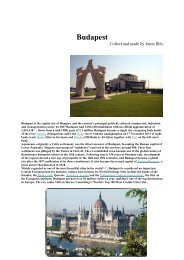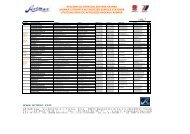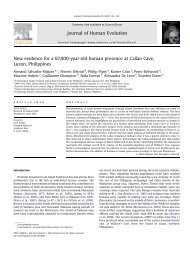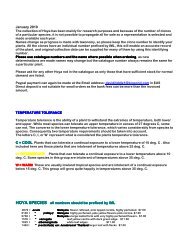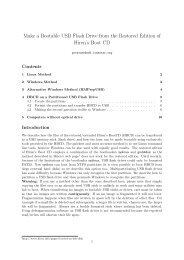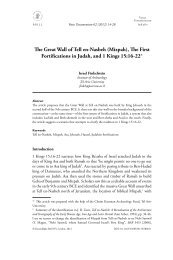ARTICLE IN PRESS Journal of Human Evolution
ARTICLE IN PRESS Journal of Human Evolution
ARTICLE IN PRESS Journal of Human Evolution
You also want an ePaper? Increase the reach of your titles
YUMPU automatically turns print PDFs into web optimized ePapers that Google loves.
10<br />
Chupasko, and Eileen Westwig for access to collections. I am<br />
grateful to Philip Rightmire, Eric Delson, W.E.H. Harcourt-Smith,<br />
and Tina Warinner for useful comments during the process <strong>of</strong><br />
identification <strong>of</strong> the specimen, and for suggestions during the<br />
preparation <strong>of</strong> this manuscript, and to Sarah Elton and two anonymous<br />
reviewers for suggestions on earlier drafts <strong>of</strong> the<br />
manuscripts.<br />
Supplementary data<br />
Supplementary data associated with this article can be found in<br />
online version, at doi:10.1016/j.jhevol.2009.08.004.<br />
References<br />
<strong>ARTICLE</strong> <strong>IN</strong> <strong>PRESS</strong><br />
Alemseged, Z., Geraads, D., 1998. Theropithecus atlanticus (Thomas 1984) (Primates:<br />
Cercopithecidae) from the late Pliocene <strong>of</strong> Ahl al Oughlam, Casablanca,<br />
Morocco. J. Hum. Evol. 34, 609–621.<br />
Ardito, G., Mottura, A., 1987. An overview <strong>of</strong> the geographic and chronological<br />
distribution <strong>of</strong> West European Cercopithecoids. Hum. Biol. 2, 29–45.<br />
Bar-Yosef, O., Goren-Inbar, N., 1993. The Lithic Assemblages <strong>of</strong> ‘Ubeidiya, a Lower<br />
Paleolithic Site in the Jordan Valley. The Institute <strong>of</strong> Archaeology, The Hebrew<br />
University <strong>of</strong> Jerusalem, Jerusalem.<br />
Belmaker, M., 2002. The first presence <strong>of</strong> Theropithecus sp. in the Southern Levant.<br />
Isr. J. Zool. 48, 165.<br />
Belmaker, M., 2006. Community structure through time: ‘Ubeidiya, a Lower Pleistocene<br />
site as a case study. Ph.D. Dissertation. The Hebrew University <strong>of</strong><br />
Jerusalem.<br />
Belmaker, M., 2009. Hominin adaptability and patterns <strong>of</strong> faunal turnover in the<br />
Lower-Middle Pleistocene transition in the Levant. In: Camps, M., Chauhan, P.R.<br />
(Eds.), A Sourcebook <strong>of</strong> Paleolithic Transitions: Methods, Theories and<br />
Interpretations. Springer, pp. 211–228.<br />
Belmaker, M., Tchernov, E., Condemi, S., Bar-Yosef, J., 2002. New evidence for<br />
hominid presence in the Lower Pleistocene in the Southern Levant. J. Hum. Evol.<br />
43, 43–56.<br />
Bramblett, C.A., 1969. Non-metric skeletal age changes in the Drajani Baboon. Am.<br />
J. Phys. Anthropol. 30, 161–172.<br />
Braun, D., Ron, H., Marco, S., 1991. Magnetostratigraphy <strong>of</strong> the hominid tool-bearing<br />
Erk el Ahmar formation in the northern Dead Sea Rift. Isr. J. Earth Sci. 40,<br />
191–197.<br />
Caloi, L., Palombo, M.R., 1997. Biochronology <strong>of</strong> large mammals in the early and<br />
middle Pleistocene on the Italian peninsula. Hystrix 9, 3–12.<br />
Cerling, T.E., Hay, R.L., 1986. An isotopic study <strong>of</strong> paleosol carbonates from Olduvai<br />
Gorge. Quatern. Res. 25, 63–78.<br />
Delson, E., 1974. Preliminary review <strong>of</strong> Cercopithecid distribution in the Circum<br />
Mediterranean region. Mémoire du B.R.G.M. 78, 131–135.<br />
Delson, E., 1980. Fossil macaques, phyletic relationships and a scenario <strong>of</strong> deployment.<br />
In: Lindburg, D.G. (Ed.), The Macaques: Studies in Ecology, Behavior and<br />
<strong>Evolution</strong>. Van Nostrand Reinhold, New York, pp. 11–30.<br />
Delson, E., 1993. Theropithecus fossils from Africa and India and the taxonomy <strong>of</strong> the<br />
genus. In: Jablonski, N.G. (Ed.), Theropithecus: The Rise and Fall <strong>of</strong> a Primate<br />
Genus. Cambridge University Press, Cambridge, pp. 157–189.<br />
Delson, E., Terranova, C.J., Jungers, W.L., Sargis, E.J., Jablonski, N.G., Dechow, P.C.,<br />
2000. Body mass in Cercopithecidae (Primates, Mammalia): estimation and<br />
scaling in extinct and extant taxa. Anthropol. Paper Am. Mus. Nat. Hist. 83,<br />
1–159.<br />
Derricourt, R., 2006. Getting ‘‘Out <strong>of</strong> Africa’’: sea crossing, land crossings and culture<br />
in the hominin migrations. J. World Prehist. 19, 119–132.<br />
Elton, S., 2002. A reappraisal <strong>of</strong> the locomotion and habitat preference <strong>of</strong><br />
Theropithecus oswaldi. Folia Primatol. 73, 252–280.<br />
Falsetti, A.B., Jungers, W.L., Cote, T.M., 1993. Morphometrics <strong>of</strong> the callitrichid<br />
forelimb: a case study <strong>of</strong> size and shape. Int. J. Primatol. 14, 551–572.<br />
Fernandes, C.A., Rohling, E.J., Siddall, M., 2006. Absence <strong>of</strong> post-Miocene Red Sea<br />
land bridges: biogeographic implications. J. Biogeogr. 33, 961–966.<br />
Galliari, C.A., 1988. A study <strong>of</strong> postnatal appendicular skeletal maturation in captive<br />
born squirrel monkeys (Saimiri boliviensis). Am. J. Primatol. 16, 51–61.<br />
Geraads, D., 1986. Ruminants Pléistocène d’Oubéidiyeh. In: Tchernov, E. (Ed.), Les<br />
Mammifères du Pléistocène Inférieur, de la Vallée du Jourdain a Oubéidiyeh.<br />
Association Paléorient, Paris, pp. 143–182.<br />
Gibert, J., Ribot, F., Gilbert, L., Leakey, M.G., Arribas, A., Martínez-Navarro, B., 1995.<br />
Presence <strong>of</strong> the Cercopithecid genus Theropithecus in Cueva Victoria (Murcia,<br />
Spain). J. Hum. Evol. 28, 487–493.<br />
Gowlett, G.A.J., 1979. Complexities <strong>of</strong> cultural evidence in the Lower and Middle<br />
Pleistocene. Nature 278, 14–17.<br />
Guérin, C., Bar-Yosef, O., Debard, E., Faure, M., Shea, J., Tchernov, E., 1996. Mission<br />
archéologique et paléontologique dans le Pléistocène ancien d’Oubéidiyeh<br />
(Israël): Résultats 1992–1994, 322. C.R. Acad. Sci., Paris, pp. 709–712.<br />
Guérin, C., Bar-Yosef, O., Debard, E., Faure, M., Shea, J., Tchernov, E., 2003. Oubeidiyeh,<br />
carrefour biogéographique et culturel entre l’Afrique et l’Eurasie au<br />
Paléolithique ancien. In: Vandermeersch, B. (Ed.), Échanges et Diffusion dans la<br />
M. Belmaker / <strong>Journal</strong> <strong>of</strong> <strong>Human</strong> <strong>Evolution</strong> xxx (2009) 1–11<br />
préhistoire Méditerraneenne. Éditions du Comité des Travaux Historiques et<br />
Scientifiques, Paris, pp. 131–146.<br />
Gupta, V.L., Sahni, A., 1981. Theropithecus delsoni, a new cercopithecine species from<br />
the Upper Siwliks <strong>of</strong> India. Bull. Geol. Soc. India. 14, 69–71.<br />
Haas, G., 1966. On the Vertebrate Fauna <strong>of</strong> the Lower Pleistocene Site <strong>of</strong> ‘Ubeidiya.<br />
Israel Academy <strong>of</strong> Sciences and <strong>Human</strong>ities, Jerusalem.<br />
Haas, G., 1968. On the Fauna <strong>of</strong> ‘Ubeidiya. Proc. Isr. Acad. Sci. <strong>Human</strong>it. Sci. 7, 1–14.<br />
Harrison, D.L., Bates, P.J.J., 1991. The Mammals <strong>of</strong> Arabia. Harrison Zoological<br />
Museum, Sevenoaks, Kent.<br />
Harrison, T., 1989. New postcranial remains <strong>of</strong> Victoriapithecus from the middle<br />
Miocene <strong>of</strong> Kenya. J. Hum. Evol. 18, 3–54.<br />
Holmes, K.M., 2007. Using Pliocene paleoclimatic data to postulate dispersal<br />
pathways <strong>of</strong> early hominins. Palaeogeogr. Palaeoclimatol. Palaeoecol. 248,<br />
96–108.<br />
Hughes, J.K., Elton, S., O’Regan, H.J., 2008. Theropithecus and ‘Out <strong>of</strong> Africa’ dispersal<br />
in the Plio-Pleistocene. J. Hum. Evol. 54, 43–77.<br />
Iwamoto, M., 1993. The ecology <strong>of</strong> Theropithecus gelada. In: Jablonski, N. (Ed.),<br />
Theropithecus: The Rise and Fall <strong>of</strong> a Primate Genus. Cambridge University Press,<br />
Cambridge, pp. 441–452.<br />
Jablonski, N.G. (Ed.), 1993. Theropithecus: The Rise and Fall <strong>of</strong> a Primate Genus.<br />
Cambridge University Press, Cambridge.<br />
Jungers, W.L., Falsetti, A.B., Wall, C.E., 1995. Shape, relative size, and size-adjustments<br />
in morphometrics. Yrbk. Phys. Anthropol. 38, 137–161.<br />
Kawai, M., Dunbar, R., Ohsawa, H., Mori, U., 1983. Social organization <strong>of</strong> Gelada<br />
Baboons: social units and definitions. Primates 24, 13–24.<br />
Kimura, T., Hamada, Y., 1990. Development <strong>of</strong> epiphyseal union in Japanese<br />
macaques <strong>of</strong> known chronological age. Primates 31, 79–93.<br />
Krentz, H.B., 1993. Postcranial anatomy <strong>of</strong> extant and extinct species <strong>of</strong><br />
Theropithecus. In: Jablonski, N.G. (Ed.), Theropithecus: The Rise and Fall <strong>of</strong><br />
a Primate Genus. Cambridge University Press, Cambridge, pp. 383–422.<br />
Kummer, H., 1995. Quest <strong>of</strong> the Scared Baboon: A Scientist’s Journey. Princeton<br />
University Press, Princeton.<br />
Langdon, J.H., 1986. Functional Morphology <strong>of</strong> the Miocene Hominoid Foot. Karger,<br />
Basel.<br />
Mallol, C., 2006. What’s in a beach? Soil micromorphology <strong>of</strong> sediments from the<br />
Lower Palaeolithic site <strong>of</strong> ‘Ubeidiya, Israel. J. Hum. Evol. 51, 185–206.<br />
Martínez-Navarro, B., 2004. Hippos, pigs, bovids, saber-toothed tigers, monkeys,<br />
and hominids: dispersals through the Levantine corridor during late Pliocene<br />
and early Pleistocene times. In: Goren-Inbar, N., Speth, J.D. (Eds.), <strong>Human</strong><br />
Paleoecology in the Levantine Corridor. Oxbow Books, Oxford, pp. 37–52.<br />
Martínez-Navarro, B., Palmqvist, P., 1995. Presence <strong>of</strong> the African Machairodont<br />
Megantereon whitei (Broom, 1937) (Felidae, Carnivora, Mammalia) in the Lower<br />
Pleistocene site <strong>of</strong> Venta Micena (Orce, Granada, Spain), with some considerations<br />
on the origin, evolution and dispersal <strong>of</strong> the genus. J. Archaeol. Sci. 22, 569–582.<br />
Martínez-Navarro, B., Belmaker, M., Bar-Yosef, O., 2009. The large carnivores from<br />
’Ubeidiya (early Pleistocene, Israel): biochronological and biogeographical<br />
implications. J. Hum. Evol. 56, 514–524.<br />
Martínez-Navarro, B., Claret, A., Shabel, A.B., Pérez-Claros, J.A., Lorenzo, C., Palmqvist, P.,<br />
2005. Early Pleistocene ‘‘hominid remains’’ from southern Spain and the taxonomic<br />
assignment <strong>of</strong> the Cueva Victoria phalanx. J. Hum. Evol. 48, 517–523.<br />
Mosimann, J.E., 1970. Size allometry: size and shape variables with characteristics <strong>of</strong><br />
the log normal and generalized gamma distribution. J. Am. Stats. Assoc. 665,<br />
930–945.<br />
O’Regan, H.J., 2008. The Iberian Peninsula - corridor or cul-de sac? Mammalian<br />
faunal change and possible routes <strong>of</strong> dispersal in the last 2 million years.<br />
Quatern. Sci. Rev. 27, 2136–2144.<br />
Opdyke, N.D., Lindsay, E., Kukla, G., 1983. Evidence for earlier date <strong>of</strong> ‘Ubeidiya,<br />
Israel hominid site. Nature 304, 375.<br />
Patel, B.A., Gilbert, C.C., Ericson, K.E., 2007. Cercopithecoid cervical vertebral<br />
morphology and implications for the presence <strong>of</strong> Theropithecus in early Pleistocene<br />
Europe. J. Hum. Evol. 52, 113–129.<br />
Petraglia, M.D., 2003. The Lower Paleolithic <strong>of</strong> the Arabian Peninsula: occupations,<br />
adaptations, and dispersals. J. World Prehist. 17, 141–179.<br />
Pickford, M., 1987. The chronology <strong>of</strong> the Cercopithecoidea <strong>of</strong> East Africa. Hum. Evol.<br />
2, 1–17.<br />
Pickford, M., 1993. Climatic change, biogeography, and Theropithecus. In:<br />
Jablonski, N.G. (Ed.), Theropithecus: The Rise and Fall <strong>of</strong> a Primate Genus.<br />
Cambridge University Press, Cambridge, pp. 227–243.<br />
Raynal, J.P., Sbihi Alaoui, F.Z., Geraads, D., Magoga, L., Mohi, A., 2001. The earliest<br />
occupation <strong>of</strong> North Africa: the Moroccan perspective. Quatern. Int. 75, 65–75.<br />
Rice, W.R., 1989. Analyzing tables <strong>of</strong> statistical tests. <strong>Evolution</strong> 43, 223–225.<br />
Rodman, P.S., 1979. Skeletal difference <strong>of</strong> Macaca fascicularis and Macaca nemestrina<br />
in relation to arboreal and terrestrial quadrupedalism. Am. J. Phys. Anthropol.<br />
51, 51–62.<br />
Rohling, E.J., Fenton, M., Jorissen, F.J., Bertrand, P., Ganssen, G., Caulet, J.P., 1998.<br />
Magnitude <strong>of</strong> sea-level lowstands <strong>of</strong> the past 500,000 years. Nature 394,<br />
162–164.<br />
Ron, H., Levi, S., 2001. When did hominids first leave Africa? New high-resolution<br />
magnetostratigraphy from Erk-el-Ahmar Formation. Isr. Geol. 29, 887–890.<br />
Rook, L., Martínez-Navarro, B., The large sized cercopithecid from Pirro Nord and the<br />
importance <strong>of</strong> Theropithecus in the early Pleistocene <strong>of</strong> Europe: Faunal markers for<br />
hominins outside Europe. Palaeontographica Abteilung A. (in press).<br />
Rook, L., Martínez-Navarro, B., Clark Howell, F., 2004. Occurrence <strong>of</strong> Theropithecus<br />
sp. in the Late Villafranchian <strong>of</strong> Southern Italy and implication for Early Pleistocene<br />
‘‘out <strong>of</strong> Africa’’ dispersals. J. Hum. Evol. 47, 267–277.<br />
Please cite this article in press as: Belmaker, M., The presence <strong>of</strong> a large cercopithecine (cf. Theropithecus sp.) in..., J Hum Evol (2009), doi:10.1016/<br />
j.jhevol.2009.08.004




